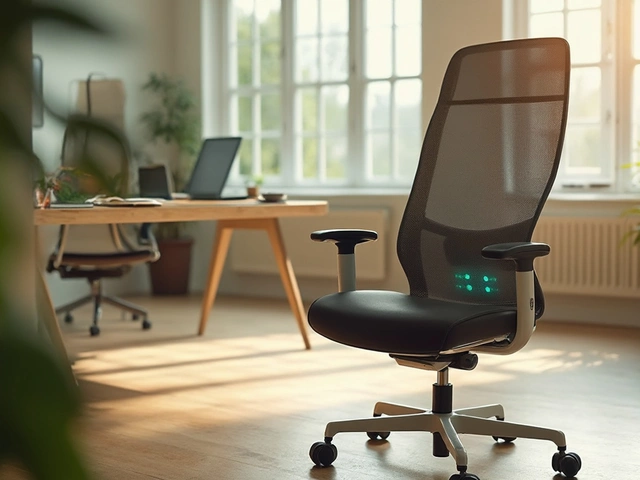Do Office Chairs Lose Their Bounce Over Time?

Ever sat down in your office chair, only to end up closer to the ground than expected? Yeah, that's the dreaded chair sinking. Most of us experience it at some point. So, why does it happen? And more importantly, how can you stop it?
The culprit is usually the pneumatic cylinder. This little component controls the chair's height adjustability, and over time, it can wear out. But don't worry, there are ways to combat this annoyance and keep your chair in top shape.
First, regular maintenance is key. Check for signs of wear and tear. Are there scratches or wobbles? These could be early warning signs. Also, avoid using your chair as a ladder or leaning excessively, as these actions can stress the cylinder.
- The Anatomy of Office Chairs
- Causes of Chair Sinking
- Preventative Measures
- When to Replace Your Chair
- Solutions for a Sinking Chair
- Choosing a Durable Chair
The Anatomy of Office Chairs
Let's break down what's really going on inside your office chair. Understanding the basic anatomy helps, especially when you're dealing with the mystery of a chair that seems to sink into oblivion.
The Base: Where Stability Begins
The base is the foundation of the chair, usually crafted from sturdy materials like aluminum or reinforced plastic. It typically features five wheels, technically called casters, to ensure balance and mobility all around your workspace.
Pneumatic Cylinder: The Heart of Adjustability
This is the part that lets you raise or lower your chair. Powered by gas or air, the pneumatic cylinder compresses when you sit down and expands when you lift the lever. Over time, wear and tear can lead to malfunction leading to that annoying sinking feeling.
| Component | Materials | Common Issues |
|---|---|---|
| Base | Aluminum, Plastic | Wheel damage, cracks |
| Pneumatic Cylinder | Metal, Gas | Leaks, loss of tension |
Seat Pan: The Comfort Zone
The seat is where you spend hours, so comfort here is a must. Covered in fabric, mesh, or leather, it's usually padded with foam for comfort. If your seat pan starts sloping forward or feels less cushy, it's a sign the materials might be degrading.
Backrest and Armrests: For Support and Posture
The backrest can be a lifesaver, especially if it includes adjustable lumbar support. It helps maintain posture. Armrests are optional but can significantly reduce fatigue. Make sure they’re adjustable to match your needs and to support your arms properly.
Understanding these components not only helps you troubleshoot issues like a sinking chair but also assists in choosing better, more durable office chairs in the future.
Causes of Chair Sinking
So, why do office chairs start acting like deflated balloons over time? Several factors could be at play, making your trusty seat lose its bounce.
Pneumatic Cylinder Wear and Tear
The main reason chairs sink is that the pneumatic cylinder, the mechanism that allows for height adjustments, wears out. Inside this cylinder is compressed air. With constant use, the seals may start to fail, leading to air leaks and a loss of pressure maintaining the chair's height.
Excessive Weight and Misuse
Sometimes, it's just a matter of following the manufacturer's weight limit. Sitting on the chair with more weight than it was designed to handle puts extra pressure on the cylinder, causing it to wear out faster. And let's be honest—leaning back too far or using the chair to reach that top shelf doesn't help.
Quality of Materials
Not all office chairs are made alike. Cheaper chairs often use lower-quality components, including the cylinder. These are prone to quicker degradation compared to those made from higher-quality materials. It's worth investing a little extra for durability.
Environmental Factors
Believe it or not, climate can affect your chair too. Extreme temperatures can impact the air pressure inside the cylinder. So, if your chair's exposed to direct sunlight or left in freezing conditions, it might not perform at its best.
Manufacturing Defects
It's less common, but every now and then, you might just have a dud cylinder. Sometimes defects occur during production, which can lead to premature failure. Check your warranty; you might have a replacement coming your way.
Understanding these causes can help you better take care of your office chair and prevent sinking issues from cropping up prematurely. It might also guide you in choosing a more durable option next time you're in the market for a new seat.
Preventative Measures
Keeping your office chair in good shape isn't as hard as you might think. Just a little attention and care can go a long way in stopping that dreaded chair sinking. Here's how to stay ahead of the game.
Regular Checks
First off, give your chair a once-over now and then. Check the base, especially the wheels. Are there any cracks or excess wear? These could hint at pressure points that need attention. The same goes for the pneumatic cylinder. If it's making strange noises, it might be time to get it looked at or replaced.
Proper Usage
Let's face it: some of us aren't the gentlest when it comes to using our chairs. Avoid sitting down with a thud or leaning back too aggressively. These small actions add up and can wear out the cylinder faster than you'd like.
Keep It Clean
Dust and dirt can sneak their way into joints and moving parts, creating friction and wear. Every few months, take the time to dust off areas like the wheels, and give the cylinder a gentle wipe. This simple step can help everything move more smoothly.
Lubrication
A little lube goes a long way. Consider applying a bit of lubricant to the moving parts of your chair. Be careful not to use too much, though – you don’t want to end up with a slippery mess.
Weight Management
Most chairs are designed to hold a certain weight. Exceeding this limit, even occasionally, can stress the chair's components. Check the specs of your chair, and make sure it matches or exceeds your needs.
By following these simple steps, your office chair should hold up better over time, saving you hassle and discomfort. Plus, your wallet will thank you when you don't need to buy a new chair as often.

When to Replace Your Chair
So, how do you know when it's time to part ways with your trusty office chair? It's not always about waiting for it to break completely. There are some tell-tale signs you should look for.
Signs Your Chair Has Worn Out
Look for the obvious physical damages like tears in the fabric or broken armrests. But that's just the surface level. Pay attention to how well your chair supports you. If you’re finding it uncomfortable, even after adjustments, it may have outlived its usefulness. Comfort and support are key, and a worn-out chair can rob you of that.
Evaluating Chair Replacement Costs
It might be tempting to ignore a sinking chair, but think about this: the cost of discomfort and potential back issues could outweigh the price of a new office chair. Prioritize your well-being over the short-term savings of sticking with an old chair.
Here's a quick checklist to evaluate:
- Physical damage (rips, scratches, or broken parts)
- Pneumatic cylinder issues causing constant sinking
- Lack of support leading to discomfort
- Damage that's not repairable
The Lifespan of a Good Office Chair
On average, a quality office chair lasts around 7 to 10 years. Of course, lifespan can vary based on usage and build quality. Are you using a high-end ergonomic chair, or a basic model? Consider upgrading if your chair is on the lower end of that spectrum.
| Type of Chair | Average Lifespan |
|---|---|
| High-end Ergonomic Chair | 7-10 years |
| Basic Office Chair | 5-7 years |
Ultimately, don't wait for your office chair to become a real pain in the back. Watch for these signs, and take action to replace it when needed. After all, investing in a good chair is investing in your comfort and productivity.
Solutions for a Sinking Chair
Alright, so your chair has turned into the office joke and it's time to fix it up. The process is not as complicated as you might think, and there are quite a few options out there depending on what you've got going on.
1. Replace the Pneumatic Cylinder
This is the most permanent solution for a sinking chair. You can buy a new pneumatic cylinder online or from office supply stores. Here’s a quick guide:
- Uplift your chair to its highest position.
- Remove the base, which usually involves loosening a few screws.
- Detach the old cylinder, and pop in the new one following its instructions.
- Reattach the base. Test the chair to ensure it locks into position.
A new cylinder typically costs between $20 to $40, way cheaper than buying a new chair!
2. The PVC Pipe Hack
If you're looking for a quick fix, this DIY straight out of the hacks playbook can do the trick.
- Measure the chair's height at a comfortable level for you.
- Cut a section of PVC pipe slightly longer than this measurement.
- Split the pipe lengthwise.
- Slide it around the cylinder. Voila! Your chair stays where it is meant to.
3. Use a Hose Clamp
Another not-so-permanent solution involves a metal hose clamp. Here’s what to do:
- Set your office chair to your desired height.
- Wrap the hose clamp around the cylinder.
- Tighten it snugly, ensuring the chair stays locked in place.
Evaluating Your Chair
Sometimes the best fix is a new chair. If you've already replaced the cylinder before or if fixing it is becoming routine maintenance, you might want to consider buying a new one. Modern office chairs come with better durability and support. Investing in a strong, reliable chair can save you stress (and embarrassing sinking moments) down the line.
Choosing a Durable Chair
Picking the right office chair is more than just about looks. When you're investing in a piece that you hope lasts, it's all about the details. A quality chair not only stays comfy over time but also resists the dreaded sinking feeling.
Materials Matter
The material of an office chair plays a big role in its longevity. Look for chairs made of strong, quality materials. Steel frames, rather than plastic, and durable fabric or leather can last significantly longer. Another thing to check is if the wheels, or casters, are built to handle the weight and frequent movements.
Pneumatic Cylinder Quality
The pneumatic cylinder is often the weak link, so it needs particular attention. Make sure it's from a reputable brand known for quality. These cylinders control the height and handle weight adjustments. If you find one with a warranty, even better!
Ease of Maintenance
A chair that's easy to maintain will generally last longer. Removable covers that can be washed and materials that don't trap dirt are ideal. Look for models with accessible parts that can be repaired or replaced if need be.
Ergonomics and Comfort
Always consider comfort. Chairs with adjustable features like lumbar support, armrests, and seat height will not only fit better but will also endure less wear over time, since they spread out the stress individuals put on the chair.
Price vs. Lifespan
While the initial cost might be higher for a high-quality office chair, it's usually worth it. Cheap chairs may save you money upfront, but they can wear out quickly. Investing a bit more in a chair that lasts can save you from frequent replacement costs. Here's a quick look at how price can affect lifespan:
| Price Range | Expected Lifespan |
|---|---|
| $100-$200 | 1-3 years |
| $300-$500 | 5-7 years |
| $600 and up | 8+ years |
In essence, finding a durable chair requires you to consider both build quality and design features. Pay more now to save later. Your future self will thank you!

